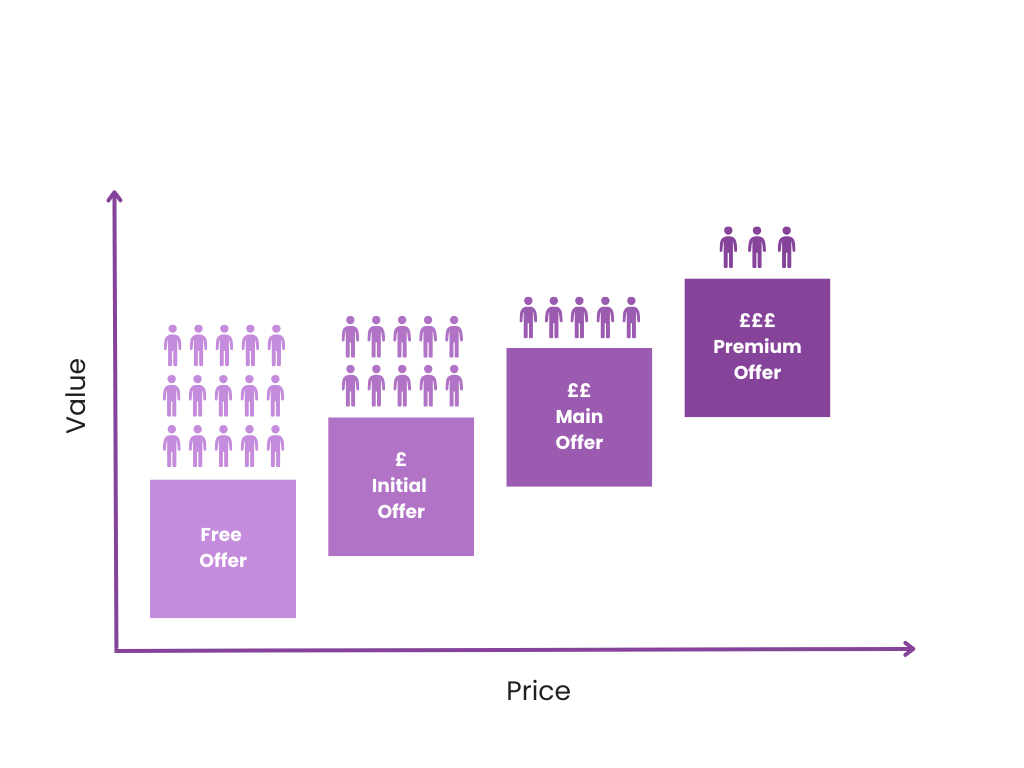Building a Value Ladder
You wouldn’t ask someone to marry you on the first date (unless you’re a wannabe MAFS reality TV star).
It’s been a while since I’ve been in the dating game, but I imagine you now swipe right, start chatting then arrange to meet for a coffee or drink.
If it goes well, one of you may suggest dinner.
As you get to know each other, you start spending more time together, going on bigger trips, a weekend away or even meeting each other’s families.
Eventually, you’re moving in or discussing your future together.
Each step builds trust and deepens the relationship before making a big commitment.
The same principle applies in business and when working with clients.
You don’t ask someone to invest in your big ticket offer the first time they encounter you. Instead, you build trust and value incrementally, guiding them through different levels of engagement you offer, particularly if you’re selling B2C.
This is where a value ladder comes in.
A value ladder helps structure your offering so that your audience can start small and gradually move toward your premium services as their trust in you grows.
It allows clients to meet you based on where they are right now.
The ladder then guides them to deeper commitments, all while increasing the value you both receive.

There is a lot of detail that goes behind each of these, but the simplicity of the framework and its clear, structured approach makes it memorable and actionable (an added dash of alliteration doesn’t hurt either).
If you look around other subject experts who are thriving, they typically have a framework they can call their own too.
Why You Need a Value Ladder
There are three key reasons why all expertise-led businesses should have a value ladder:
- Meet Clients Where They Are
Not everyone is ready to jump into a high involvement and investment offer immediately (indeed I’d argue that if this was the case, it might raise some warning signs).By offering different levels of service, you can engage clients at the stage they’re most comfortable with.Start with coffee first, then suggest dinner.
- Build Trust Over Time
Trust is earned step by step. As your clients engage with your lower-tier services and see the value you deliver, their confidence in your expertise grows.They’re more likely to move up to your higher-value offers because you’ve demonstrated that you can deliver results at each stage.
- Maximise Revenue Opportunities
By creating a value ladder, you open multiple streams of revenue. While some clients may never move beyond your entry-level offers, others will climb the entire ladder and invest in your most premium services.This structure ensures you’re providing value and generating income at every stage of the relationship and not leaving money on the table.
Structuring your Value Ladder
Here’s a breakdown of the typical steps in a value ladder and what you might offer:
1. Free Offer
The first step in any relationship is offering something of value for free. This could be a blog, podcast, webinar, or a lead magnet like a downloadable guide or checklist. The goal here is to attract your audience’s attention and give them a taste of what you can offer, with no strings attached.
Daniel Priestley talks about the 7-11-4 rule. He argues that for a typical client to convert, they need to interact with 7 hours of content over 11 interactions, across 4 different touch points.
The numbers are up for debate, but the point remains valid. You need to build your credibility and get buy-in without your direct involvement.
Examples:
- Social content on LinkedIn or YouTube
- Free e-book, whitepaper or how-to guide
- Free webinars or recorded training sessions sessions
- Blog posts
- Podcasts (either your own or someone else’s – preferably the latter as you can reach new audiences)
- Scorecard
Of course, an often overlooked benefit of this is that the client becomes accustomed to your ideas, values and approach before they even start working with you, which in turn makes them a better client.
It can also filter those out that aren’t a good fit, without you having to screen them manually.
Many people worry that by giving away lots of their insights they are in essence cannibalising their own business. This couldn’t be further from the truth. You monetise the implementation, and distribute information for free (at scale) to attract this work.
2. Initial Offer
Once your audience has sampled your free content, the next step is to offer a low-cost product or service that allows them to engage more deeply with you. This could be a mini-course, a one-off consultation, or a paid resource. It’s a small commitment that offers real value, helping them experience the benefit of working with you without a significant investment.
We have often heard it called a ‘trip-wire’ offering and is useful to get rid of the ‘tyre-kickers’. The key here is that it forces the client to invest, even if this is a relatively small amount.
At Candle Digital we run discovery workshops before we engage heavily with a potential client.
These do several things:
- Provide the client with real value in helping them unpick their idea.
- Test their propensity to purchase. If they baulk at the idea of spending money to get their online learning idea right, then they aren’t right for us.
- Gives both sides a low investment way to check that we’re a good fit for each other. We spend nearly 8 hours working together, and if it’s a struggle then embarking on a bigger project isn’t the right way forward for either side.
Examples:
- Short online course
- One-hour paid consultation
- Low-cost e-book, toolkit or resource pack
- Monthly membership or paid newsletter
3. Core Product/Service
By now, your audience has seen the value you provide, and they’re ready for something more. At this stage, you offer mid-tier products or services, such as a full online course, group coaching, or ongoing consulting packages.
This is where the relationship starts to deepen, and clients begin to experience more transformational results.
Examples:
- Full online course or workshop
- Group coaching program
- Ongoing consulting package
4. High-Ticket Product/Service
This is your signature offer and is the one that delivers the most value and transformation. By the time clients reach this stage, they’ve already engaged with your lower-tier services and trust you to deliver high-impact results.
This could be one-on-one coaching, a comprehensive consulting package, or a long-term program designed for maximum transformation.
You may find that when you design your high ticket offer, it’s difficult to distinguish this from your core offering. Don’t worry. To start, just have one core package, then extend this over time.
Examples:
- Comprehensive consulting or coaching packages
- VIP membership or subscription
- Intensive training programs
5. Premium Product/Service
For your most dedicated clients, you offer an exclusive service. This is something that’s only available to a select few. These could be high-ticket mastermind groups, private retreats, or custom solutions tailored specifically to their needs.
This is where the biggest investments happen, and the relationship reaches its peak.
Examples:
- Private masterminds or exclusive retreats
- Custom consulting solutions
- One-on-one VIP mentorship
Creating your Value Ladder
Building a value ladder begins with understanding who your audience is and what they need at every stage of their journey.
Start by analysing your current and prospective customers. What do they frequently ask for? What challenges are they facing?
By identifying patterns in their needs, you can design offers that meet them where they are, whether they’re just starting out and looking for free content or ready for a more in-depth, higher-value service.
Another key step is speaking directly with your audience. Reach out to both current clients and prospects to gather insights about what they value and how they’d like to engage with you.
This could be through surveys, interviews, or casual conversations. These discussions can help you pinpoint where gaps exist in your offerings and how you can create services that address their evolving needs.
As you collect this feedback, start mapping out your value ladder. Consider the natural progression of services that guide clients from an initial low-commitment offer to more comprehensive, higher-value options.
Don’t overcomplicate it. Begin with a simple, clear path that reflects how your clients typically engage with you, and refine it as you learn more about what works for them.
The most important thing is to get started.
So, what action are you going to take today to create your value ladder?
Fresh insights direct to your inbox
Join the Candle Digital mailing list




